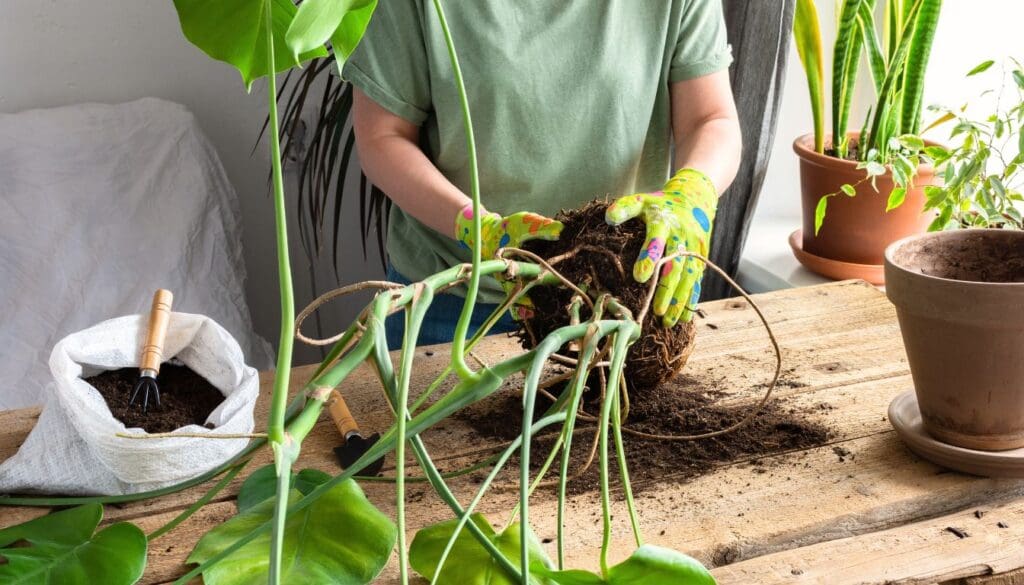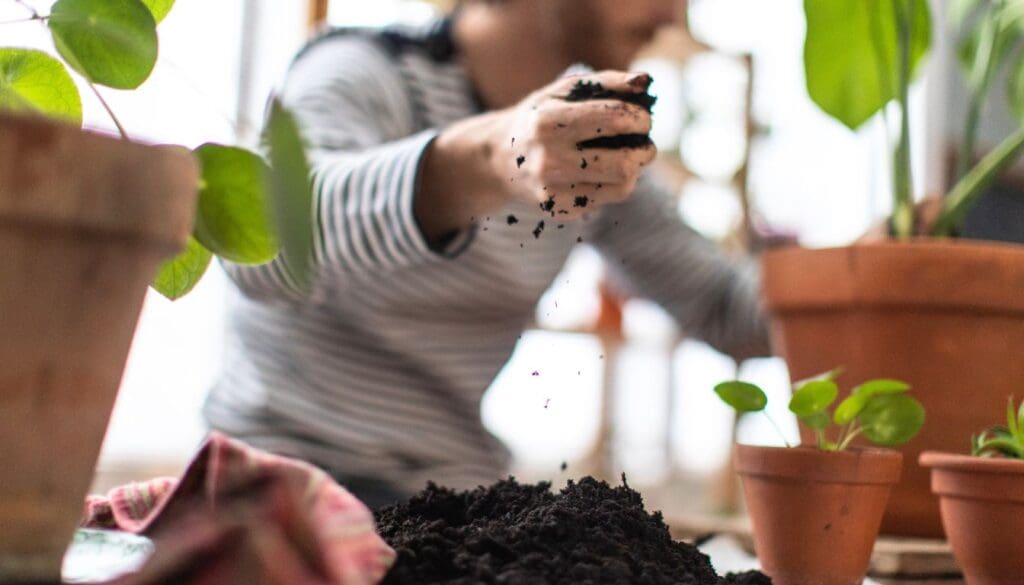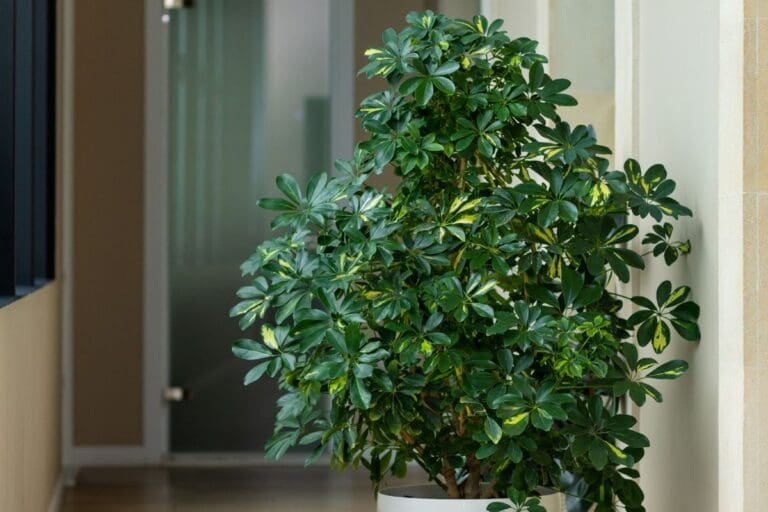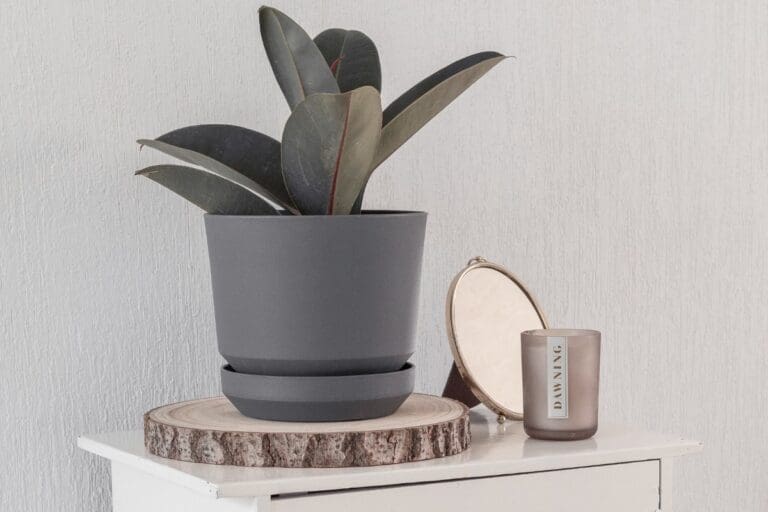Root Rot In Monstera: Signs, Causes, and Treatment
Monstera, a beautiful plant, adds aesthetic value to any corner of the house with its lovely fenestrations. Unfortunately, it can become susceptible to root rot under unsuitable conditions.
Common signs of root rot in Monstera include wilted or discolored leaves, stunted growth, brown and mushy stems, roots with black spots, and a foul smell. Excessive moisture is the leading cause of the problem, and repotting it is the best way to fix it. However, if the damage exceeds 50%, you might have to collect and propagate healthy parts.
In my 12 years of gardening, many of my Monsteras suffered from root rot, but I managed to save them. Today, I will share the signs, causes, treatment, and prevention of root rot in Monsteras.

Please note: Simplify Plants is reader-supported. Some links in the post are affiliate links and I get a commission from purchases made through links in the post.
Early signs of root rot in Monstera
When you identify the early signs of root rot in Monstera, you can take immediate action and save your plant from deteriorating more.
The early root rot signs in Monstera are:
- Stunted growth
- Wilted leaves
- Yellow leaves
When the roots begin to rot, it becomes difficult for them to transfer the nutrients and moisture to the other plant parts.
Hence, it will stop growing.
Over time, the leaves wilt and turn yellow.
Expect the damage level to be only 10-20%.
Advanced signs of root rot in Monstera
When you ignore the early root rot signs, your Monstera will start deteriorating, increasing the damage level by 30-40%.
However, you can still save it if you act immediately.
The advanced root rot signs in Monstera include:
- Soft and discolored stems
- Black spots on the leaves
- Foul smell from the plant base and soil
These signs signify that the disease has spread throughout the plant.
Once you notice these signs, inspect the plant thoroughly, including the roots.
When root rot sets in, the roots turn dark brown or black and become soft and mushy.
When you go near them, they will stink horribly.
The stronger the smell, the more severe the infection.
Monstera beyond saving from root rot

If you miss the above signs of root rot in Monstera, the damage level will increase by 50-60%, and the plant will be beyond survival.
At this point, the entire main stem becomes soft and mushy, and all the roots die.
The dead roots and rotten stems won’t be able to transport any moisture or nutrients, and the plant will die soon.
Causes of root rot in Monstera
Too much moisture in the soil causes root rot in Monsteras.
Fungi that love moisture also contribute to root decay.
But what causes excessive moisture levels in the soil? Below are some causes of prolonged wet soil and root rot:
Overwatering can cause root rot in Monstera
Overwatering is the main cause of root rot in Monsteras. Sadly, it is one of the easiest methods to cause root rot.
Overwatering can suffocate plant roots and hinder nutrient and moisture uptake.
Over time, the roots get soft and start rotting. Wet soil can also attract fungi, worsening root decay.
The rule is to let the top 2-3 inches of the soil dry before you water your Monsteras.
Instead of following any routine, check the soil moisture before every watering.
You can either use your finger to check the moisture, or use a 3-in-1 moisture meter.
Monstera suffers from root rot due to poor drainage

When discussing drainage in Monsteras, two things must be considered: a pot with drainage holes and well-drained soil.
Pots and soil require good drainage to prevent water retention.
Without drainage, excess water leads to prolonged moisture, which causes root rot.
It’s crucial to ensure proper drainage for healthy plants.
Use a pot with drainage holes.
For better results, use a terracotta pot, which wicks away moisture faster and reduces the risk of overwatering.
A good soil mix for Monsteras would be 1 part peat, 1 part coco coir, and 4 parts pine bark fines.
For other options, read our Monstera Soil article.
Monstera in big pots can cause root rot
Big pots can also cause root rot in Monsteras.
A reader messaged me about her Monstera plant suffering from root rot despite proper watering, soil, and pot type.
After seeing a picture, I discovered the pot was too big.
Bigger pots hold a lot of soil and hence take time to dry out.
The roots stay wet for so long, become soft, and start rotting.
Over time, fungi will reach the roots and increase the rotting.
Use a pot based on the plant size.
When repotting, choose a pot only 1-2 inches larger than the old one.
Fungal infections cause root rot in Monsteras
Root rot is a fungal infection that affects Monsteras during prolonged exposure to wet conditions.
Overwatering and poor drainage can lead to root rot but can be prevented with proper care.
But you cannot stop the disease if the soil already contains disease-causing fungi, like Pythium, Rhizoctonia, and Fusarium.
The fungus travels from one place to another through air and insects.
Your Monstera will be attacked by the fungus whenever the soil gets waterlogged.
Monsteras suffer from root rot during cold climates
The next reason that can cause root rot in Monsteras is the cold climate.
Monsteras thrive in warm environments.
Their metabolism decreases when temperatures and light levels drop, causing slow growth and reduced water and nutrient absorption.
For this, the soil takes a lot of time to dry out.
If you are not careful about watering, you might overwater and cause root rot.
You should reduce the watering frequency in the fall and winter. Let the top few inches dry out.
Rocks on the bottom of the pot can cause root rot in Monstera
Rocks at the bottom of a Monstera pot can improve drainage is a misconception in some cases.
They only prevent soil from falling out.
Soil acts like a sponge, absorbing water until fully saturated.
Putting rocks raises the soil level, making it harder for water to drain.
Plants grown in pots with rocks are in shallower soil that doesn’t drain any better.
Underwatering causes root rot in Monstera
I was surprised when I learned that underwatering can cause root rot in Monsteras.
One of my friends shared this with me.
When you don’t water the Monsteras for a long time, the roots adapt to the dry spell, shrinking and becoming compact.
It causes the pot to have a rootless soil section, similar to putting the plant in a larger pot.
Since the roots have adapted to dry conditions, sudden moisture can shock them.
It takes time to dry out and causes root rot.
Treating and recovering root rot in Monstera in 9 easy steps

Once you have learned the causes and signs of root rot in Monstera, it is time to treat the stressed plant.
Here is a step-by-step guide to treat the root rot in Monstera and help in quick recovery:
Step 1: Take out the Monstera and check the roots
Once you notice the signs of root rot in Monsteras, take out the plant to check the roots.
Slowly tap the sides and edges of the pot to make removal easier.
You don’t need to water it for easy removal as the soil is already wet.
After removing, remove maximum soil from the roots to check its condition.
If needed, rinse the roots to have a precise observation.
Step 2: Remove the decayed roots
Prune the damaged roots from your Monstera.
Some will come off quickly, and some need to be pruned.
Trim off the brown and mushy roots from the plant.
You may trim some long, thin, and entangled roots if needed.
Step 3: Let the roots dry out a bit
Keep the roots in a dark and well-ventilated area and let them dry a bit.
Don’t keep it like that for too long.
Otherwise, the roots will get dehydrated and give rise to other issues.
Step 4: Disinfect the remaining healthy roots and the soil
Disinfect the remaining healthy roots of your Monstera with a fungicide.
You can use natural fungicides instead of commercials. Here are some options:
- Hydrogen peroxide: Mix one tbsp or 1 part of 3% strength hydrogen peroxide with one cup or 3 parts of water and use the solution to the remaining healthy roots.
- Cinnamon: Dust the infected roots with cinnamon powder. It will prevent the remaining roots from getting affected and stimulate new root growth.
- Baking soda: Mix 3 tbsp of baking soda with one gallon of warm water and spray the solution on the Monstera stems and roots.
- Apple cider vinegar: Mix 3 tbsp of the vinegar with one gallon of water and spray on the Monstera leaves, stems, and roots.
- Neem oil: Mix one tsp of neem oil with 1 liter of water and a couple of drops of dish soap to emulsify the mixture and drench the soil with the mixture.
Step 5: Use a new pot and soil mix

The old pot and the soil mix of the Monsteras are probably infected with the root rot fungus.
It is better to dispose of them and get a new soil mix and a pot.
Disinfect the new soil mix and the pot, too.
Use a well-drained potting mix.
One good soil mix is 1 part peat, 1 part coco coir, and 4 parts pine bark fines.
You can consult our soil article for more options.
Use a pot 1-2 inches bigger than the old one to give the roots enough room for development after recovery.
It will prevent rootbound and further repotting.
To prevent high moisture levels, use a terracotta pot that wicks away moisture quickly and contains drainage holes.
Step 6: Repot the Monstera
Fill half the pot with the soil mix, make a hole at the center, plant the Monstera, spread the roots properly, and cover them with the remaining potting mix.
Leave 1-2 inches of space from the pot’s top. Pat the sides gently.
Step 7: Prune the infected leaves

Prune the discolored leaves from your Monstera to encourage it to use the energy behind growing new leaves.
After repotting, you might notice some yellowing or slow growth in the plant.
It is a sign of repotting stress.
Don’t worry, and continue providing all the basic care without stress.
It won’t have any yellowing once it adjusts to the new environment.
Step 8: Take good care of the plant
You can water the plant after repotting, but I suggest watering after 1-2 days.
Also, keep it under lowlights for 1-2 days. It will give the roots some time to heal.
Water the plant thoroughly until the excess drains out.
Let it have bright indirect sunlight and maintain warm temperatures and average humidity.
While watering, you can try using a root rot treatment product like Houseplant Resource Center – Root Supplement, Liquid Root Stimulator – for Fiddle Leaf Fig & Indoor Plants – Propagation Promoter, Root Rot Treatment – Food for Healthy Roots, Stems, & Leaves – 8 Oz.
The product will help the roots heal and prevent the disease from returning.
Don’t fertilize the plant unless you notice new growth.
Step 9: Propagate the Monsteras
If you notice that your Monstera has gone beyond saving, find some healthy parts of the plant and propagate it to get new plants.
Discard the remaining plant.
Root rot prevention and maintenance in Monstera

Though you can revive your Monstera from root rot, prevention is the best way out because sometimes the plant dies.
Here are some preventive measures:
- Monstera’s potting mix should drain well while retaining enough moisture and contain 5.5 to 6 pH levels. Mix some coarse sand or orchid bark into the potting mix to improve soil aeration, or use 100% LECA.
- Use a pot with drainage holes. If you overwater often, use terracotta pots or self-watering pots. When repotting, use a pot that’s only 1-2 inches larger than the old one.
- Water your Monstera whenever the top few inches have dried. Keep the soil consistently moist, neither too wet nor too dry. Water more when the temperature goes above 68°F and reduce the frequency in the fall and winter.
- Do not add any gravel or decorative stones at the pot base. Well-drained soil and a pot with drainage holes will be enough for drainage.
- If there’s a saucer under your Monstera pot, please empty it occasionally.
- Allow good ventilation around your Monstera plant. It will help the soil to dry out, prevent high humidity, and keep fungus and bacteria at bay.
- Maintain around 40-60% of humidity. If it’s high, increase airflow to keep the humidity in check by running a fan or opening a window.
- Keep an eye on your Monstera for signs of stress, like discolored leaves, defoliation, stunted growth, or wilted leaves. If you notice any of these signs, identify the causes and take immediate action to solve and prevent the issue from spreading.
Final thoughts
Root rot can kill your Monstera. However, you can save your plant by early detection and treatment. The common root rot signs are discolored and wilted leaves, stunted growth, defoliation, soft brown stems, black spots on the leaves, and foul smell from the soil. Upon deep inspection, you will notice brown and mushy roots releasing a foul smell.
At times, you will see only dead roots. Common causes of root rot are overwatering, poor drainage, big pots, cold climate, high humidity, fungal infections, rocks at the pot base, and underwatering. To treat root rot in Monstera, remove the plant, inspect the roots, cut off the damaged roots, spray the healthy roots with fungicide, and repot your plant in a new pot with a new potting mix.
Take care of the plant after repotting by providing adequate sunlight, water, temperature, and humidity. Fertilize after a week when you notice new growth. Though you can save the plant from the disease, prevention is the best way out. Use well-drained soil, prioritize drainage, maintain good aeration and airflow, and use the right pot size.
Is root rot contagious to other plants?
Root rot is a fungal disease. Besides excessive moisture, fungal spores in the water or soil can also cause the issue. So yes, it will spread to the other plants if you use the soil or water harboring the fungal spores.
Will my Monstera recover from root rot?
You can easily save your Monstera if you identify the early signs of root rot. You can save it in the advanced stages, but it will be difficult.
Can I fix root rot in Monstera without repotting?
Early detection and treatment can save your Monstera from root rot without repotting.
Reference: Monstera Wikipedia, Root rot Wikipedia
Recommended Garden Supplies
| Product Image | Our Recommended Gardening Supplies | Check Offers! |
|---|---|---|
Top Top
Top
Top
Top
Top
Top
Top
Top | rePotme Houseplant and Tropical Classic Potting Soil Mix | Check Offer On Amazon |
 Top
Top
Top
Top
Top
Top
Top
Top | Espoma Organic Indoor Plant Food | Check Offer On Amazon |
 Top
Top
Top
Top
Top
Top
Top
Top | GooingTop LED Grow Light 6000K Full Spectrum Clip Plant Growing Lamp | Check Offer On Amazon |
 Top
Top
Top
Top
Top
Top
Top
Top | Soil Moisture Meter | Check Offer On Amazon |
 Top
Top
Top
Top
Top
Top
Top
Top | Govee Hygrometer Thermometer, Bluetooth Enabled! | Check Offer On Amazon |
 Top
Top | LEVOIT Humidifiers for Large Room(Best For Plants) | Check Offer On Amazon |
 Top
Top
Top
Top
Top
Top
Top
Top | Upgraded DIY Automatic Drip Irrigation Kit, 15 Potted Houseplants Support | Check Offer On Amazon |
 Top
Top
Top
Top
Top
Top
Top
Top | Stainless Steel Heavy Duty Gardening Tool Set | Check Offer On Amazon |
 Top
Top
Top
Top
Top
Top
Top
Top | Bonide Insecticidal Soap | Check Offer On Amazon |
 Top
Top
Top
Top
Top
Top
Top
Top | Bonide 32 oz Spray Neem Oil for Organic Gardening | Check Offer On Amazon |
 Top
Top
Top
Top
Top
Top
Top
Top | Garden Safe Fungicide | Check Offer On Amazon |







Thanks that hepls a lot